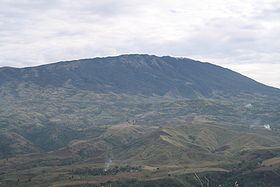Elevation 2,450 m | Mountain type Compound stratovolcano Last eruption unknown | |
 | ||
Similar Mount Sumagaya, Latukan, Mount Kalatungan, Leonard Kniaseff, Mount Amorong | ||
Mount Balatukan is a massive compound stratovolcano in the southern island of Mindanao, Philippines. The volcano has no historical eruptions but displays fumarolic activity. The 2,450-metre (8,040 ft) mountain is topped by a triangular shaped caldera 15 kilometers (9.3 mi) long and 10.6 kilometers (6.6 mi) at its widest. The Balatocan River emanates from and drains the huge crater.
Contents
- Map of Mount Balatukan Gingoog Misamis Oriental Philippines
- LocationEdit
- Physical featuresEdit
- VolcanismEdit
- ListingsEdit
- References
Map of Mount Balatukan, Gingoog, Misamis Oriental, Philippines
The mountain is a protected area in the country classified as a Natural Park, the Mount Balatukan Range Natural Park. The park has an area of 8,423.00 hectares (20,813.7 acres) with a buffer zone of 1,222.00 hectares (3,019.6 acres). It was created on March 6, 2007 by Proclamation no. 1249.
LocationEdit
Mount Balatukan is wholly located in Province of Misamis Oriental in the Northern Mindanao region of the Philippines. The coastal road between Balingasag, Misamis Oriental and Gingoog City rims the northern perimeter of the mountain on the north coast of Mindanao.
Physical featuresEdit
Mount Balatukan is a stratovolcano with a listed elevation of 2,450 meters (8,040 ft) asl (GVP). The Philippine Institute of Volcanology and Seismology (PHIVOLCS).
Satellite imagery shows it to be densely forested peninsula jutting north into the Bohol Sea.
VolcanismEdit
There are no historical eruptions on Mount Balatukan. The age of its last eruption has not been studied, although some lava flows on the sides of the mountain are determined as Pleistocene. Fumarolic activity is present on the mountain, but its form displays extensive erosion.
Balatukan is part of the Central Mindanao Arc of volcanoes. Its northernmost tip called Sipaka Point, which points to the northeast, is a 267 meters (876 ft) cinder cone on a small peninsula called Mount Sipaka.
ListingsEdit
The Global Volcanism Program lists the last activity of Balatukan as Holocene but Uncertain.
Philippine Institute of Volcanology and Seismology (Phivolcs) lists Balatukan as Inactive, even though the volcano displays fumarolic activity.
